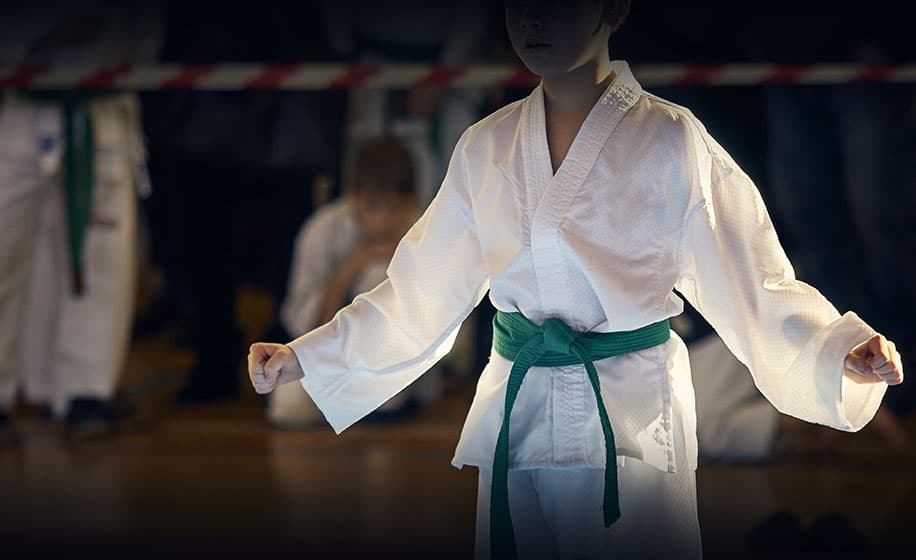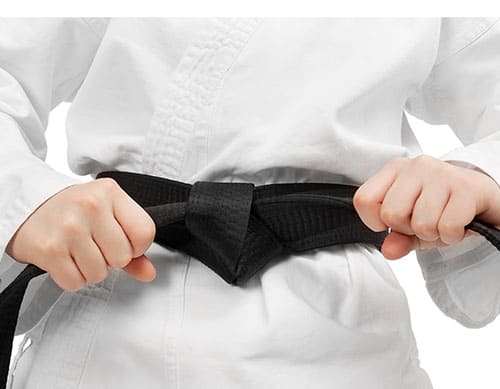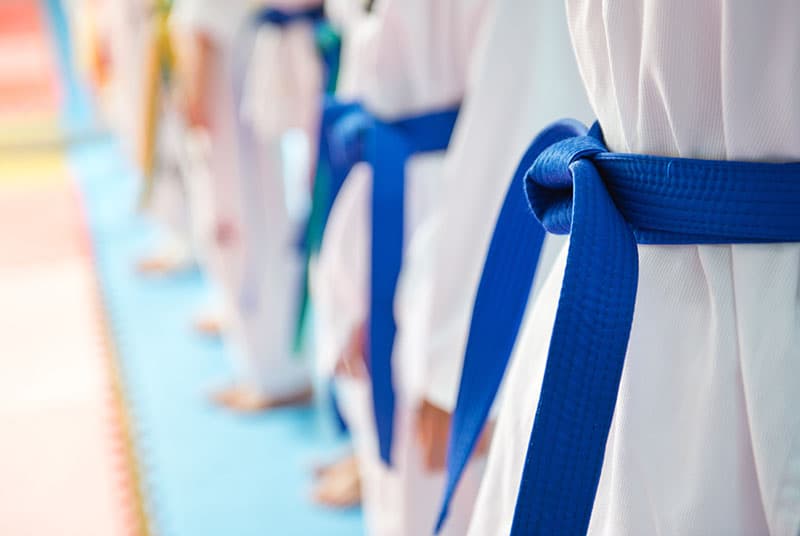
When I started TaeKwonDo I had never really given much consideration to the meaning of the belt colors or even what was the order of the belts in Taekwondo and the reason(s) for it. I assume that I am not the only one, so with that in mind, I did some research and found the answers to this question.
History of the Belt System
The Taekwondo belt system in the early days started with just white, yellow, green, brown, and black as these are considered the six true or natural colors. However, today many schools have added additional colors—such as orange, blue, and red—which students receive as they advance toward their ultimate goal: obtaining a black belt.
The modern belt system of Taekwondo was developed in the early 1940s and is often symbolized as the growth of a tree or as the journey from infancy to adulthood. This visible progression breaks down the process of going from a white belt (symbolizing yang or beginnings) to a first-degree black belt (symbolizing yin or the culmination of basic training).
Additional Note:
It is important to mention that different Taekwondo organizations (such as World Taekwondo [WT] and the International Taekwondo Federation [ITF]) may use slightly different belt systems and testing methods.
For example, while WT schools typically follow a colored belt progression similar to what is described below, ITF schools sometimes include additional intermediate ranks. Always check with your school for their specific system.
Traditional Belt Levels

I remember when I first started that I could not wait until I could wear another belt other than white. I remember feeling somewhat embarrassed walking into class wearing my uniform and holding my white belt.
Of course, I did not understand the underlying significance of that belt—or any of the others—and how they relate to the advancement of a Taekwondo student. As time went on and as I continued to progress in my training, I became more and more aware of the significance of the colors of each belt. They were not just randomly chosen but thoughtfully arranged to mirror the growth and development of the student (or me).
I became aware that these colors each have their own meaning and therefore I soon became proud of each new belt as it signified my growth in this martial art.
Taekwondo Belt Order and What Each Belt Color Means
White Belt
This belt symbolizes innocence or purity. All beginning students, who have no prior experience with Taekwondo, start with this belt. It represents a clean slate and the beginning of a journey.
Yellow Belt
This color signifies the earth and represents the planting of a seed, establishing the foundation on which growth can occur. At this stage, the student begins to create the basis for learning Taekwondo.
Green Belt
The green belt stands for growth—just like a seed that sprouts and begins to flourish. At this level, the student’s skills in Taekwondo continue to develop, building upon the foundation laid at the yellow belt level.
Brown Belt
The brown belt means that the tree is growing and maturing. Likewise, the student’s techniques and skills continue to improve as they advance into more challenging and refined levels of training.
Blue Belt
Blue represents the sky or heaven—the stage where the plant (or student) reaches upward, beginning to transform into a towering tree. The student is becoming stronger and more mature in their practice.
Red Belt
The red belt signifies danger and serves as a warning—both to the student and to others. At this level, the student must be mindful of their newfound skills and exercise control. This is typically the last belt before achieving a black belt.
Black Belt
The black belt, the opposite of white, signifies that the student has matured to the point where they have completed their basic training in Taekwondo.
- For the Non-Martial Artist: A black belt is often seen as the pinnacle of mastery.
- For the Student: It symbolizes just the beginning of true mastery and a lifelong journey of learning.
To review the form you need to learn for each belt, check out my forms section.

Black Belt Levels
Once you have earned your black belt, your training truly begins. There is a system of levels within the black belts themselves that, in brief, goes as follows:
1st through 3rd Degree: Considered a kyo sah nim or assistant instructor.
4th through 6th Degree: Considered a sah bum nim, functioning both as an instructor and a master.
7th through 9th Degree: Considered a kwan jang nim or grand master. This rank usually requires the practitioner to be at least 40 years old.
10th Degree: An honorary belt, awarded to those who have profoundly affected the development and spread of Taekwondo worldwide or given posthumously to practitioners with a lifetime of demonstrable contributions to the art.
Black Belts Under the Age of 15
The style promoted by World Taekwondo (WTF), which is the most widely practiced in the U.S., recognizes a “poom” rank for students under the age of 15. These students have passed dan-level tests but do not receive an official dan-level rank until they reach 15. In some schools, holders of the poom rank wear a half-red/half-black belt rather than a solid black belt.
How Long to Get a Black Belt in TaeKwonDo?
How long it takes depends mostly on you and how much do you train but is not as much about time as it is about three main criterion:
- Knowledge
- Skill
- Character
Of course, the quality of instruction (or lack thereof) also plays an important part as good instruction can keep things moving along or delay your improvement. For example, I have seen students just try to coast by and the instructors did not correct them or push them. Then, come testing time, the student doesn’t understand how they didn’t past.
Naturally, your advancement also depends on what your physical and mental capabilities are so assuming an average physical ability (you will improve during your training) and say 4 hours or so training per week, a black belt will take you 3 – 5 years depending on the school and instructors.
Bottom Line: In order to become proficient you need train at home and get the necessary instruction at the school – It’s all about you and what you put into it.
Can I Wash My Taekwondo Belt?

Traditionally, it is believed that you should never wash your Taekwondo belt, as doing so is thought to wash away the history and knowledge you have accumulated through your training. The natural wear and aging of the belt serve as a visual record of your journey.
Modern Perspective:
While the traditional view holds strong, many contemporary schools recognize the importance of hygiene and may advise gentle cleaning methods. Some instructors suggest spot-cleaning or airing out the belt rather than a full wash, thereby balancing respect for tradition with practical care. Ultimately, practices may vary between schools, so it’s best to follow the guidelines set by your instructor or organization.
Additional Considerations
- Variations in Belt Systems:
While this article focuses on the most commonly seen progression, note that there are variations depending on the organization and country. For instance, some schools introduce extra intermediate belt colors (such as purple or gold) to mark specific skill milestones. Always consult your school’s curriculum for the most accurate information regarding their belt progression. - Modern Emphasis on Holistic Development:
Many contemporary schools emphasize not only physical prowess but also mental discipline, ethical behavior, and even academic learning as part of Taekwondo training. This broader educational approach helps students develop a well-rounded character in addition to martial skills.
Final Thoughts
There’s an old story about a new student who asked his teacher how long it would take for him the earn his black belt.
The teacher answered, “three to five years, perhaps.”
The student replied, “What if I train hard every day? How long would it take me then?”
“Seven to ten years,” replied the teacher.
“What if I train for eight hours, every day?!” said the student. “How long then, teacher?”
“Twenty years,” said the teacher.
Getting your black belt is not a race or a timed course. A good teacher will take everything into account and should not put you in for any belt exam until he/she thinks you’re ready. Remember that TaeKwonDo is something will become a part of your everyday life and not something to graduate from and then leave. It can be whatever you want it to be.

